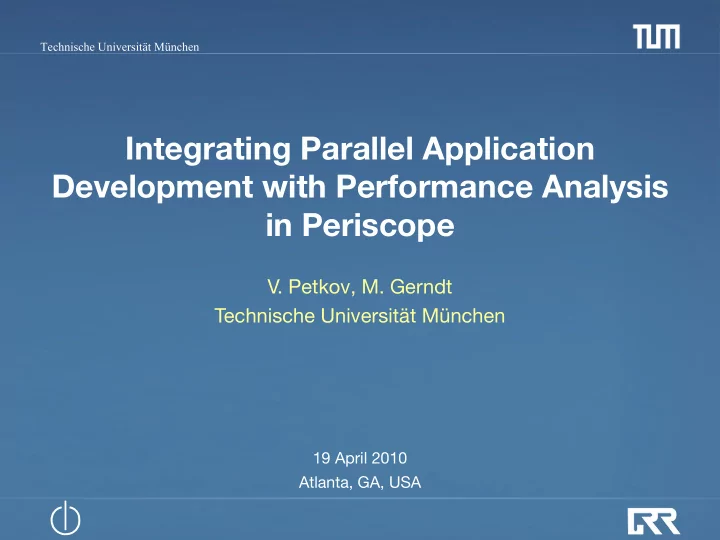

Technische Universität München Integrating Parallel Application Development with Performance Analysis in Periscope V. Petkov, M. Gerndt Technische Universität München 19 April 2010 Atlanta, GA, USA
Motivation Common performance analysis procedure on Power6 systems – Use Tprof to pinpoint time-consuming subroutines – Use Xprofiler to understand call graph – Use hpmcount (libhpm) to measure HW Counters Problem – Mostly post-development process → Learning new tools required → Hard to map bottlenecks to their source code location – Routine, error-prone and time-consuming Solution – Automate performance analysis – Integrate parallel application development and performance analysis within the same IDE Ventsislav Petkov, petkovve@in.tum.de
Related Work • Tools having separate user interfaces – Tailored to gain maximum flexibility when presenting the collected data – Often hard to map the detected bottlenecks to their exact source location – External to user's development environment → impose greater learning overhead → require switching of applications (development/analysis tools) – Examples are Vampir, SCALASCA, IBM HPCS Toolkit, etc. • Tools being integrated in existing IDEs – Provide smooth transition between the analysis results and their source code regions – Tend to be easier to use as the developers do not have to learn new user interfaces and/or different tools – Examples are VTune, TAU, HPCToolkit, PPW, etc. Ventsislav Petkov, petkovve@in.tum.de
Periscope performance analysis toolkit On-line – no need to store trace files Distributed – reduced network overhead – based on autonomous cooperating agents Analyzes: – Single-node Performance • Intel Itanium2 • IBM Power6 • x86-based Systems – MPI Communication – OpenMP Performance Supports: Fortran, C/C++ Ventsislav Petkov, petkovve@in.tum.de
Periscope GUI Overview Integrates with the Eclipse Development Platform – Open-source, extensible and very popular IDE – Supports different programming languages: C/C++, Fortran, etc. – Uses the Eclipse Parallel Tools Platform (PTP) which provides a higher-level abstraction of the underlying parallel system Designed to combine – Performance measurement functionality of Periscope – Advanced IDE functions like code indexing, refactoring, etc. Features – Multi-functional table to display the detected bottlenecks – Outline of the instrumented code regions – Clustering techniques to get classes of similarly behaving processes – Supports both local and remote projects – Higher-level configuration and execution of performance experiments Ventsislav Petkov, petkovve@in.tum.de
Periscope GUI Overview Source code editor Project explorer Instrumentation outline view Periscope properties view Ventsislav Petkov, petkovve@in.tum.de
Periscope GUI: Properties Table Multi-functional table based on the OSEE XViewer – Simple and clean tree-based overview – Multi-level grouping – Complex data filtering – Multiple criteria sorting algorithm – Navigation from the properties to their source code location Ventsislav Petkov, petkovve@in.tum.de
Periscope GUI: Instrumentation Outline Standard Intermediate Representation (SIR) View – Resembles the code outline view of the Eclipse C/C++ Development Tooling – Outlines the instrumented code regions and their nesting – Shows the number of properties in each region – Assists code navigation – Filters the displayed properties Ventsislav Petkov, petkovve@in.tum.de
Periscope GUI: RDT and EFS Eclipse File System (EFS) – Abstracts the underlying file system details → Any supported file system can be used: Remote projects using SSH/FTP/DStore, Local, Zip, etc. – Source files of the analyzed application reside only on the remote → no need for synchronization Remote Development Tools (RDT) – Part of Eclipse Parallel Tools Platform (PTP) Project – Remote Compilation – Remote Indexing – Currently supports only C/C++ applications Ventsislav Petkov, petkovve@in.tum.de
External Tools Framework Integration External Tools Framework (ETFw) – Part of Eclipse Parallel Tools Platform (PTP) Project – More convenient environment using ETFw's Profile launch configuration → no terminal access needed → higher level configuration and automation possible Ventsislav Petkov, petkovve@in.tum.de
Clustering support Cluster 1 CPUs: 7-10,16 Properties summarization Cluster 2 CPUs: 2-3,5,11,13-14 – Metaproperties Cluster 3 CPUs:1,4,6,12,15 Cluster 2 Property 1 Needed for peta-scale PA Cluster 1 Identify hidden behavior Property 2 Based on the Weka workbench: Cluster 3 – Waikato Environment for Knowledge Analysis – Uses K-Means algorithm Property 3 – Groups properties based on CPU distribution and code region Results shown in a table view similar to the properties view Ventsislav Petkov, petkovve@in.tum.de
Future Work Management and comparison of multiple experiments Enhancing the clustering functionality – Add pre- and post-processing steps to improve the quality of the results – Use attribute selection techniques to highlight the most variable data points Sharing the collected data with other performance tools – Integrate with a generic performance database, e.g. PerfDMF (TAU) – Allow the developer to easily apply more than one tool on the same project Ventsislav Petkov, petkovve@in.tum.de
Technische Universität München Thank you for your attention! Further information: http://www.lrr.in.tum.de/periscope
Recommend
More recommend